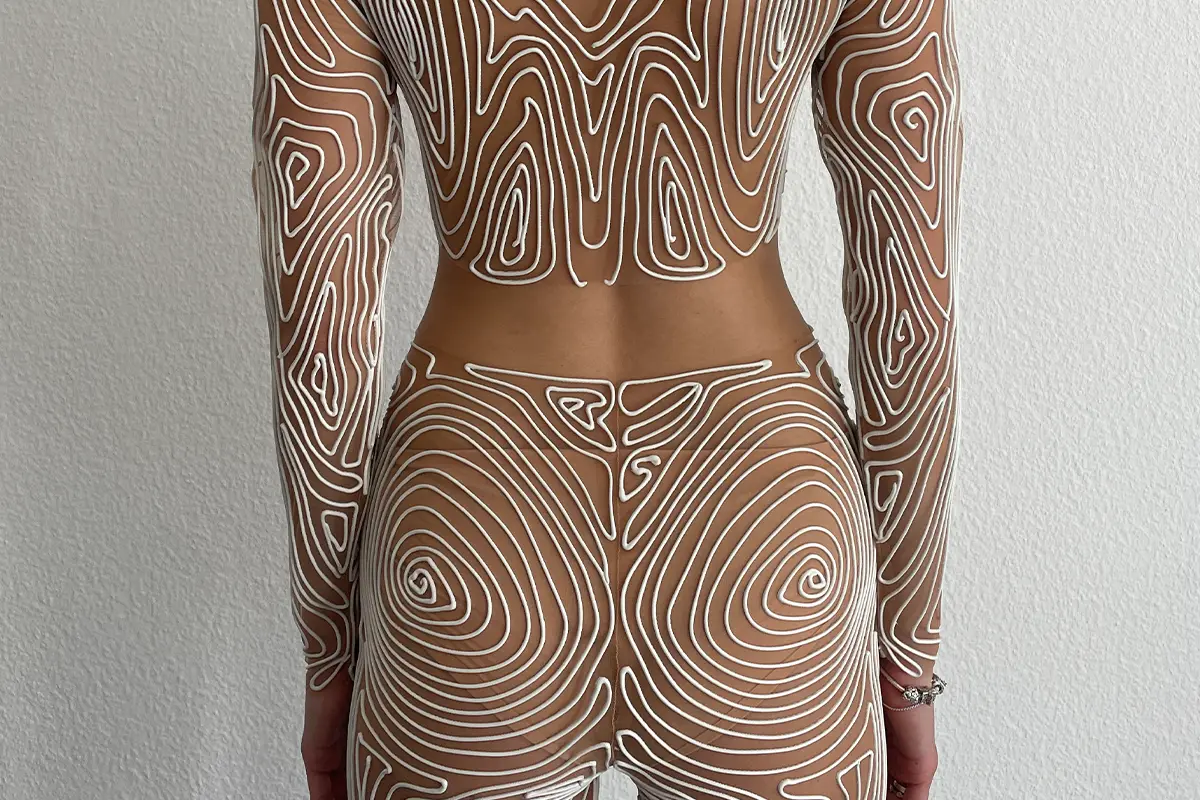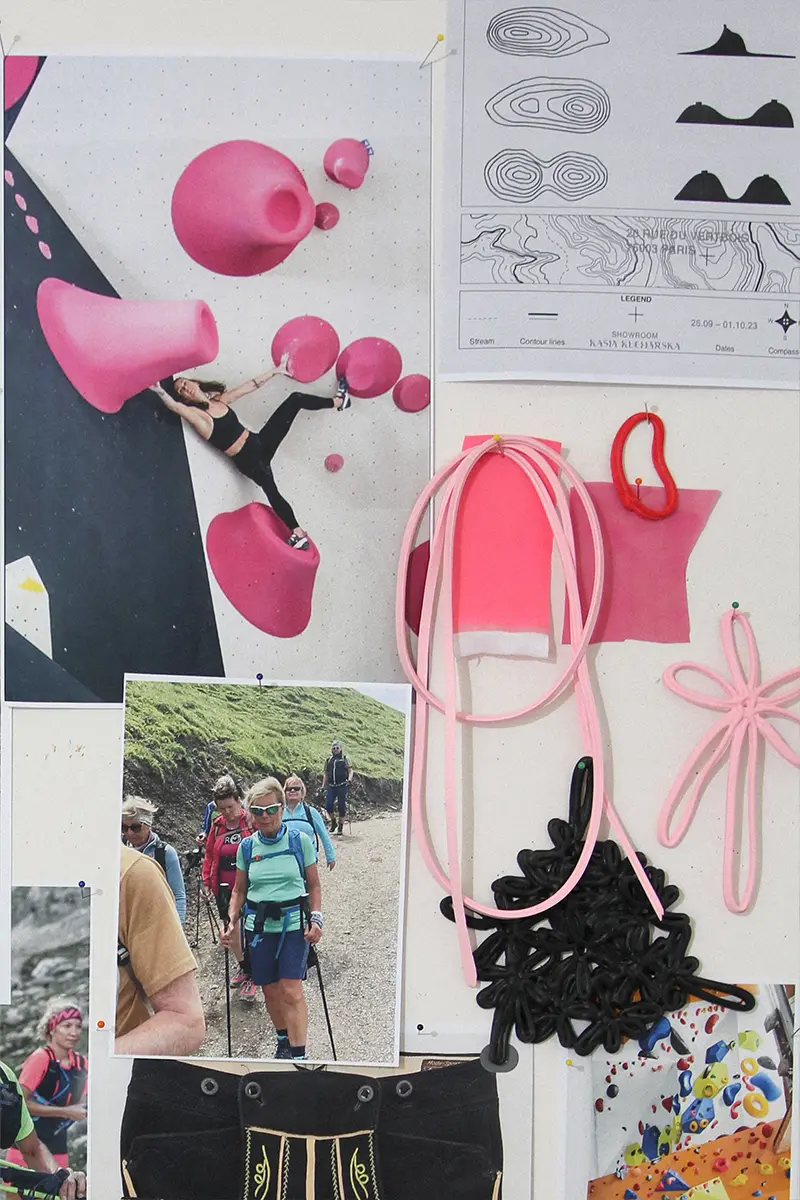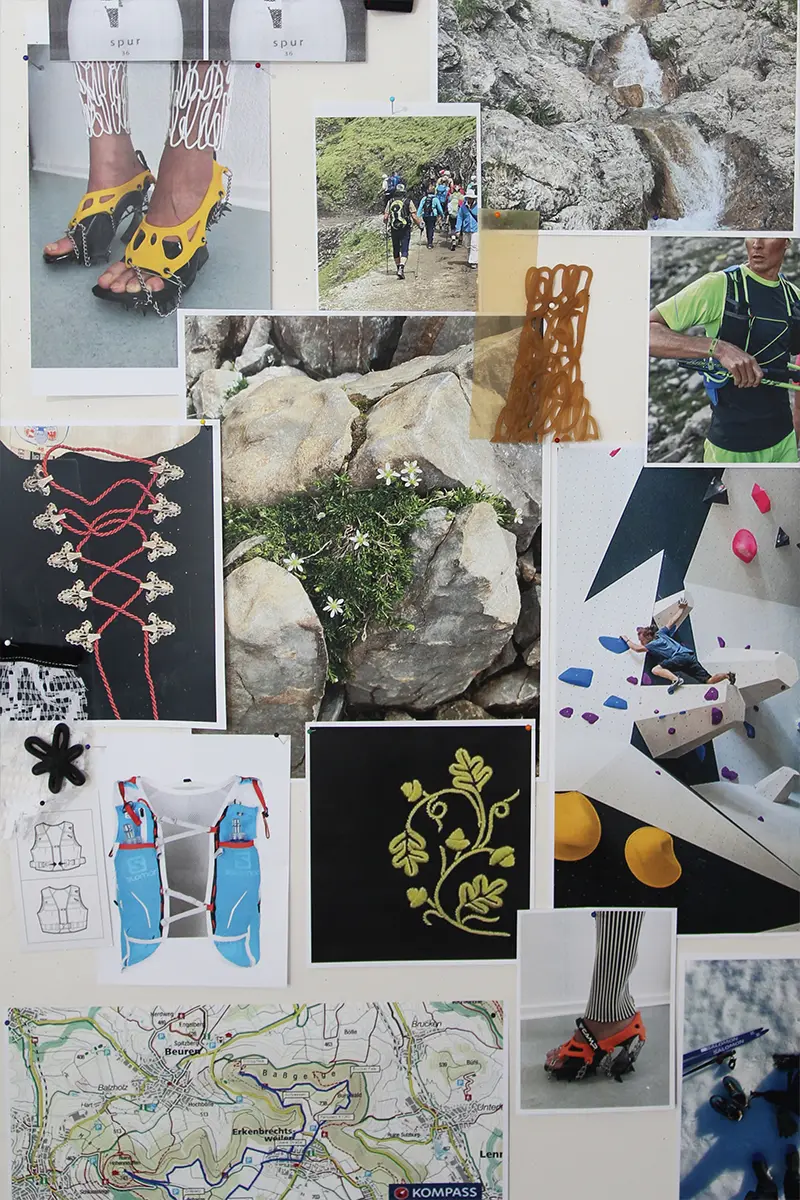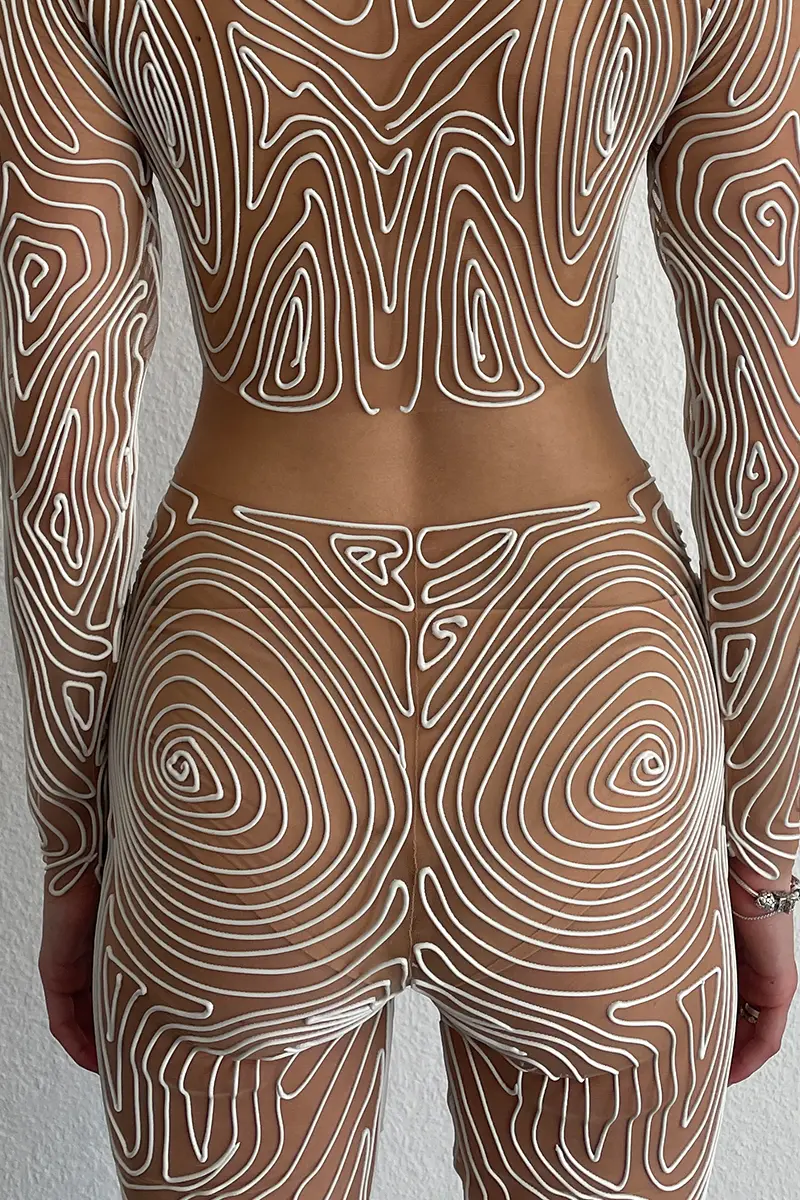Ornament is crime: Kasia Kucharska talks with Lampoon about fashion, architectural background and the next step of the sustainable textile industry – with Latex
Kasia Kucharska – an architectural view of fashion and the future of sustainable textile industry
A loyal graduate, Kasia Kucharska’s started as an architect to realize after three years that her future was in textiles. She swapped South Germany for Berlin, got her MA in fashion design, and never left town. Not because of the Berlin halo above her pieces – Kucharska shows in Paris and caters an international clientele – but because it works well as a base for living and booting up a radical brand. Kucharska centers future craft by researching materials and constructions outside of fashion – for fashion. She also focused on a sustainable textile approach for her collection
Shaped like microbial or neural networks, Kucharska’s printed lace strips form garments for the intrepid wearer. Her frisky, eccentric ‘lace’ looks seem to crawl up the entire body and come in unworldly shades like poison green and bloodred. Fresh white as well, but it may turn brown soon since natural fibers biodegrade with time. At this point only God knows how long that takes – through the permaculture community of Allgäu has promised her it will. Anna Roos van Wijngaarden asked Kucharska about borrowed architecture, nostalgia in the mountains – with a sports edge, and lace lingerie that isn’t boring.
Structure is an architectural property, but it lends itself for textiles and garment assembly as well. Kasia Kucharska’s vision
KASIA KUCHARSKA
It all came from architecture. I was always working with textiles. As a little girl I was draping and fooling around with materials, but after high school I felt like nah – should I study it? Is this even a job? I didn’t consider it. That’s why I went into architecture first, which I also loved. But then, attending those courses, I just had to translate what I learnt about design, aesthetics, and geometry to garments. Because in my head there were always garments. We were learning about the details in architecture and what makes great design, and my mind was like: okay, trousers would need to finish there, so that the shoe looks good from that angle.
ANNA ROOS VAN WIJNGAARDEN
Did that idea come from a specific architectural theory?
KASIA KUCHARSKA
In design there’s something called a shadow gap. It’s basically a line that divides two items and if you make it big and deep enough, it looks like there is a gap. This is also an element in car design. When the door closes, there’s this gap so you can always see the door. I grew up in Germany, so cars are a serious topic and there is a specific word for that, Schattennut. It is this little space that divides car elements that defines if the car is well designed or not.
I studied interior design and there was this big part about how you construct furniture. Take for a chair or a table, how do you make a big trunk look light and floating, even though it is a big thing and it’s heavy? With which design techniques can you achieve that? I was translating that to garments.
Ideas come from architecture – function and the sustainability in the industry according to Kasia Kucharska
ANNA ROOS VAN WIJNGAARDEN
Did transferring structure and construction to fashion come natural to you in practice?
KASIA KUCHARSKA
Garments are all about construction. Maybe not as much with the latex pieces we focus on right now, but in shirting for example, you look at the size of the button placket, the positioning of patterns and how they come together, what kind of seam you’re using – is it just a cheap overlock or a French seam? These details change the shape of the garment, such as how the sleeve falls. Things don’t just come together and just by chance look good. And the ideas come from architecture.
Kasia Kucharska: the in-depth design process of the architect
ANNA ROOS VAN WIJNGAARDEN
The in-depth design process of the architect is not self-evident for the modern-day fashion designer.
KASIA KUCHARSKA
The kind of products that architects create, which are houses but also furniture, are meant to last for a long time and not just for a season. I also like that idea in clothing, but it is not easy to apply – exactly because of those seasons. We’re a small team and create in-house. We try to stick with the same process we followed when it all started. For our first collection, we took time to develop our ideas, choosing our own pace even when the world around us made it seem like there wasn’t much time – and it was a great time. We still do two collections a year but left the complicated crazy campaign shoots and events on the side. Instead, we focus on design.
Ornament and Crime: Kasia Kicharska idea of sustainable fashion based on Adolf Loos
ANNA ROOS VAN WIJNGAARDEN
Which architects do you look up to?
KASIA KUCHARSKA
Peter Zumthor. He lives in the Swiss mountains. His work is pure and effective, stripped down from everything unnecessary.
ANNA ROOS VAN WIJNGAARDEN
Did you follow his philosophy when you were preparing for the Kasia Kucharska collection 2024?
KASIA KUCHARSKA
Not at all. What we do is, I would say, the opposite of what he’s doing. We are working a lot with ornamentation. I don’t think he ever did. But he’s on my mind.
Another person is Adolf Loos. He wrote a book called Ornament and Crime which basically says that all ornament is a crime if it doesn’t fulfill a function. That is what we’re trying to do: we create functional ornaments with our printing technique.
The function at the center: architecture lessons from Kasia Kucharska
ANNA ROOS VAN WIJNGAARDEN
What is the function of Kasia Kucharska?
KASIA KUCHARSKA
The whole idea and technique started with looking at how female underwear or lingerie is made. When you look closely at tights or bras, they always have this sticky silicon inlay to hold everything in place. It’s usually hidden – you don’t see it, but you need it. So, my idea was to create a functional ornament and bring the function to the outside of the garment. Make it wearable. And you don’t need that sticky inlay anymore.
This was our starting point and now, even when we develop other garments like dresses or a blouse, this is always in my head. How can we do something in a different way, with another textile, for another type of garment. What function does it fulfill? That is the first question.
Researching something as complex and artisanal as traditional lace. How far can we take this? Kasia Kucharska wonders
ANNA ROOS VAN WIJNGAARDEN
Kasia Kucharska latex body suits are not lingerie per se, right?
KASIA KUCHARSKA
It could be lingerie. It could be anything.
ANNA ROOS VAN WIJNGAARDEN
Do you have a muse in mind when you’re designing? Somebody you could see wearing it.
KASIA KUCHARSKA
Our pieces are for any woman who dares to wear it. Someone fearless in life, going her own way, not caring about anyone or anything. Don’t take yourself too seriously, be silly. It’s not for everyone. I mean, I create fashion to have fun with.
ANNA ROOS VAN WIJNGAARDEN
Besides your fascination with functional lingerie, you have a thing for lace. The organic shapes in your designs remind of it.
KASIA KUCHARSKA
True, everything came from lace underwear. The bulky stuff you see on cheap underwear nowadays – that’s not real lace. My inspiration came from looking at not-modern underwear for women where I felt like: who wants to wear these? My designs are like a post-modern take on that. This is awful, let’s make it even weirder. How far can we take this?
When I got into the history of lace, I was rather shocked. The development of traditional lace is the craziest invention in fashion. It was always women doing this by hand with insane techniques. After the Industrial Revolution we got machines to do the job faster, and there is nothing wrong with that if it is well done. There are some old machines in Italy, for example, but also Germany or Switzerland, that take a lot of time to make beautiful, expensive lace. Looking at all these impressive basic types of lace I was like: my god, is this all that is left? I started to develop my own.
Kasia Kucharska’s core raw material is rubber. But what comes from nature doesn’t have to be ecophile. The ambivalence of using latex for fashion that lasts
ANNA ROOS VAN WIJNGAARDEN
You’re working with biodegradable latex.
KASIA KUCHARSKA
Latex Is a natural material. It’s white and fluid when you harvest it from the rubber tree. They are not in Europe, but mostly in Asia, like Malaysia and Thailand. That’s where all the rubber comes from in this world – all the condoms. I have friends who are doing condoms here in Berlin and their factory is right next to the forest. We first have to get the latex over here. We get it delivered in big milk boxes, like tons of soup, and then we print it. Usually, latex is known as sheet material. You would cut out the patterns and glue it together, but we went one step up in the production chain working with a liquid material.
ANNA ROOS VAN WIJNGAARDEN
A natural phenomenon indeed, until you add finishes and color.
Latex and the sustainable textile industry for Kasia Kucharska
KASIA KUCHARSKA
Latex is a tricky and bitchy material. If you don’t add protection against the environment like the sun [UV], it starts degrading quickly. You don’t want it to biodegrade immediately. Maybe later when you don’t want it anymore, but our garments should stay for a while.
For the next collection, for the first time, we’re going to use latex without adding pigments. Using these natural colors as they come and change over time. If you purchase an item, in the beginning it will be white or yellowish, and after a year it might turn brown. To get this patina in latex is an exciting thing. I have nothing against natural pigments. To me there are no ‘bad colors’ that need to be hidden.
If you do want a specific color, you need something that takes out the natural. Because when the milk is super fresh, it is white. Then it starts to take on darker shades. We derive all colors from different natural processes. We determine the colors in the studio and align with our producers: can this color be mixed at scale? Is it reproducible? We have this one pigment that looks like an acidy, yellowish green and it doesn’t last even for a month until it gets dark. It’s vibrant, lively, and popular. People like it, but we’re like fuck, we cannot deliver this color.
Sustainable textile industry for Kasia Kucharska: some of our garments are made solely out of latex, but we also print on other textiles like mesh
ANNA ROOS VAN WIJNGAARDEN
Seems like one hell of a process to get through for suppliers as well.
KASIA KUCHARSKA
Our techniques were never used in a latex context before. I’ve been working so much with this material during my Master’s. (Back then I was still working with silicon. Latex came in later because it is more durable.) You have to pour the latex first, going line by line, like scribbling, drying it in the oven, then sewing it all together. My god it took me two days to finish a single garment. And I was like there must be a machine that I can program to do the same dumb thing I do by hand.
Some of our garments are made solely out of latex, but we also print on other textiles like mesh. We found parties for both in Europe – unfortunately not in Asia next to the trees. It was a lot of work to find someone willing to do this with us, to spend all this time experimenting.
But the process gives me such a nice feeling, like you have latex now, but what else can you do? We’ve only worked with techniques and machines that didn’t come from fashion design. And there are many more methods – currently used to do completely different things like folding cardboards or construction stuff. Sewing is old-fashioned. Is this the only way we can think of to create garments? Is this it?
ANNA ROOS VAN WIJNGAARDEN
Should we park environmentalism – it’s there and that’s that?
KASIA KUCHARSKA
I sometimes get tired of how brands are manifesting this for themselves and making it such a focus.
Biodegradability is complicated – Kasia Kucharska’s sustainable textile
ANNA ROOS VAN WIJNGAARDEN
And biodegradability is complicated. You cannot just dig a hole and put a Kasia Kucharska in the earth to degrade, right? What about the sustainable textile industry?
KASIA KUCHARSKA
I took this research seriously last year and spent weeks in Allgäu speaking to people involved in permaculture. I brought some of my pieces and asked them: how would you say this is biodegradable? Because it’s also just something that people told me. And apparently it is, but it takes years. I learnt that even a balloon biodegrades in seven years. Our garments will take longer, but it does biodegrade – according to the Allgäu people.
We’re in the process of putting different types of garments in different environments such as normal home compost. Apparently, it degrades quickly when you put it in a box with an earth and warmth. But we also have pieces lying outside of our studio the whole year round. With UV, if it gets enough sun, it does change. After one year you can already see the color fade and you can break it to pieces. That is why you have to protect our pieces when you buy them, put them in a drawer and not in plastic, because it could damage the material.
ANNA ROOS VAN WIJNGAARDEN
Does the wearer get a manual with the order to prevent those things from happening?
KASIA KUCHARSKA
Use cotton as a cover. Garments should be kept in a dry and dark place. Don’t hang it on metal hangers because like plastic, it can break it down.
Paris Womenswear Spring/Summer 2024. Kasia Kucharska takes the lifestyle of South Germany’s mountaineers to push innovation and function to the forefront, but make it fashion
KASIA KUCHARSKA
On our mood board you can find mountains, hiking gear, and high-performance sports. These are all close to my heart.
ANNA ROOS VAN WIJNGAARDEN
Do you like the mountains?
KASIA KUCHARSKA
I Grew up in the south of Germany, hiking a lot. I remember the innovation around all these performance sports. How every year there was another upgrade in skis. How else can you design them? What shape works best to make them faster? The same goes for outdoor apparel. Many new techniques used today were not there when I was young.
ANNA ROOS VAN WIJNGAARDEN
Do I sense a bit of nostalgia?
KASIA KUCHARSKA
Yeah, for sure. It’s a place close to my heart. I like bringing it to Berlin, so I have a bit more of that here.
ANNA ROOS VAN WIJNGAARDEN
I didn’t grow up with mountains – the Netherlands don’t have any, but I go to Allgäu from time to time to this little village. It’s called Sonthofen.
KASIA KUCHARSKA
My hometown is literally fifteen kilometers south. I moved to Oberstdorf when I was like five years old. I love that place. I don’t know if you enjoy it – maybe I’m just growing old, but whenever I go there it is so recharging.
Mountains and nature – the sustainable inspiration according to Kasia Kucharska
ANNA ROOS VAN WIJNGAARDEN
That’s interesting, because this place is pure nature, and then you decide to take this rather futuristic tech route in business.
KASIA KUCHARSKA
That is also what Allgäu is. You have this secure nature, like walking out of the house for 200 meters and there will be no one. Only grass and mountains. The people are super sporty out there. There is nothing there, so you have to move, whether it’s trail running, biking, or skiing. And that is where technologies like e-bikes and wearables come in. People are using this crazy gear to move in the natural environment.
ANNA ROOS VAN WIJNGAARDEN
And you’re bringing the mix to Paris in the summer of 2024.
KASIA KUCHARSKA
Recreating all the hiking gear but making it fashionable. It’s gonna be bitch goes hiking.
Kasia Kucharska
Kasia Kucharska is a multidisciplinary designer. Fresh from her Master’s degree in Fashion Design at the Universität der Künste in Berlin in 2019, with previous studies in interior architecture in Stuttgart and Japan, in her work she tries to integrate her cultural background by applying to couture the materiality and graphic stroke typical of the world of Architecture.
























